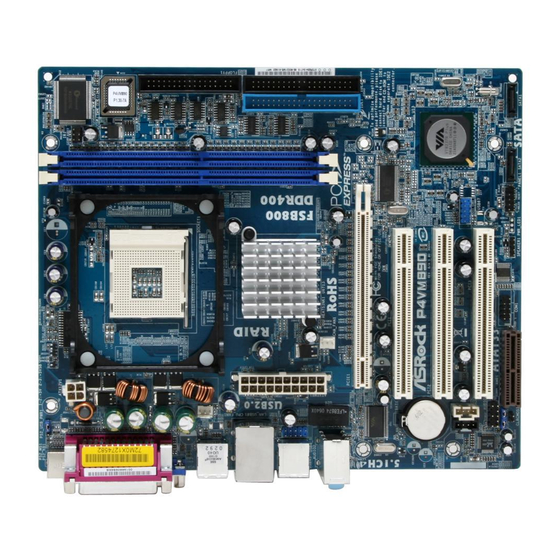Table of Contents
Advertisement
Quick Links
Download this manual
See also:
User Manual
1. VIA BIOS RAID Installation Guide ....................................................................................................... 2
1.1
Introduction of RAID ............................................................................................................. 2
1.2
RAID Configuration Precautions ............................................................................................. 3
1.3
BIOS Configuration Utility ...................................................................................................... 3
1.3.1
Enter BIOS Configuration Utility .................................................................................. 3
1.3.2
Create Disk Array ..................................................................................................... 3
1.3.3
Delete Disk Array ..................................................................................................... 6
1.3.4
Select Boot Array ..................................................................................................... 6
2. VIA Windows RAID Installation Guide ................................................................................................... 7
2.1
Create RAID Array ............................................................................................................... 8
2.2
Delete Disk Array ................................................................................................................. 10
2.3
Check All Disks ................................................................................................................... 10
2.4
Verify Mirror Disk ................................................................................................................. 11
2.5
Synchronize Mirror Disk ........................................................................................................ 12
2.6
Disk Error Detection ............................................................................................................. 13
2.7
Duplicate Critical RAID 1 Array ............................................................................................... 13
2.8
Rebuild Broken RAID 1 array ................................................................................................. 13
VIA RAID Installation Guide
Advertisement
Table of Contents

Summary of Contents for ASROCK P4VM890 R2.0
-
Page 1: Table Of Contents
VIA RAID Installation Guide 1. VIA BIOS RAID Installation Guide …………………………………………………………………………………………. 2 Introduction of RAID ………………………………………………………………………………………………. 2 RAID Configuration Precautions ………………………………………………………………………………… 3 BIOS Configuration Utility ………………………………………………………………………………………… 3 1.3.1 Enter BIOS Configuration Utility ………………………………………………………………………. 3 1.3.2 Create Disk Array ……………………………………………………………………………………….. 3 1.3.3... -
Page 2: Via Bios Raid Installation Guide
JBOD (Spanning) A spanning disk array is equal to the sum of all drives. Spanning stores data onto a drive until it is full then proceeds to store files onto the next drive in the array. When any member disk fails, it will affect the entire array. JBOD is not really a RAID, and it does not support fault tolerance. -
Page 3: Raid Configuration Precautions
Please use two new drives if you are creating a RAID 0 (striping) array for performance. It is recommended to use two SATA drives of the same size. If you use two drives of different sizes, the smaller capacity hard disk will be the base storage size for each drive. For example, if one hard disk has an 80GB storage capacity and the other hard disk has 60GB, the maximum storage capacity for the 80GB-drive becomes 60GB, and the total storage capacity for this RAID 0 set is 120GB. - Page 4 Create RAID 0 If RAID 0 array is selected in step 2, user can also select a block size for the array. Use the arrow key to highlight the “Block Size” and press <Enter>. Then the list of available block size will popup. The block size can be selected from 4K to 64K Bytes.
- Page 5 Create RAID 1 The data on disk drives will be destroyed if user uses “Auto Setup” to create RAID 1. But you can reserve the data on source drive if you use “Select Disk Drives” to select the source and the mirror drive.
-
Page 6: Delete Disk Array
Press Y to delete a specific array or press N to cancel. Delete a disk array will destroy all the data on the disk array except RAID 1. When a RAID 1 is deleted, the data on these two hard disk drives will be reserved and become two normal disks. -
Page 7: Via Windows Raid Installation Guide
You are allowed to configure RAID functions under Windows environment. The “RAID Software” is a Windows-based software utility with graphical user interface and provides user an easy-operation tool to configure and manage disk drives or disk arrays connected to VT8237 SATA controller. -
Page 8: Create Raid Array
RAID 0. Then a “Select Array Creating Method” will be prompted. Auto: The software will configure the available hard disk drives to be a disk array. User can modify the hard disk drives later. It is strongly recommended to use this method. Custom: Disk array is arranged by user. - Page 9 You can reserve the data on the source drive after clicking “Create” button when you create a RAID 1 array. There is a limitation if user wants to keep the data on the source drive the capacity of the mirror drive must be greater or equal to the source drive, otherwise the RAID 1 can’t be created.
-
Page 10: Delete Disk Array
Click “Yes” to restart the computer or click “No” to skip the restarting. New setting will take effect only after restarting. Warning: Deleting a disk array will destroy all the data on the disk array except RAID 1. When a RAID is deleted, the data on these two hard disk drives will be reserved. -
Page 11: Verify Mirror Disk
Data on the mirror disk must be the same as its corresponding source disk to provide fault tolerance for RAID 1. Select a RAID 1. Right-click the selected RAID, and then a shortcut menu will appear. Click “Verify Mirror” to verify whether the source and the mirror disks are identical. -
Page 12: Synchronize Mirror Disk
For RAID 1, it must be synchronized when data on the mirror disk is not identical with its corresponding source disk. Sometimes the data on the mirror disk may be newer than the source disk. For example, the source disk is absent and the mirror disk runs in the tolerance mode. So the exact meaning of “Synchronize Mirror”... -
Page 13: Disk Error Detection
A message will pop up when synchronization is finished. Rebuild Broken RAID 1 array If, during the system-booting, the failure or absence of any member disk of RAID is detected, the array will be marked as broken status. If broken... - Page 14 A dialog box will pop up to indicate the RAID is broken. Click Yes. Then another dialog box will pop up. If the source or the mirror disk drive is unplugged only, click “Cancel” to stop rebuilding step. Shut down the system.
- Page 15 A warning message will pop up. If you want to rebuild the RAID by using the disk drive that you selected in the previous step, click “Next”. Warning: The data on the selected disk drive will be lost. Reboot the system.









